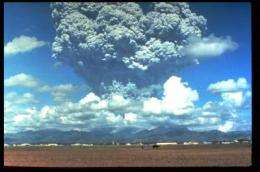Oscillating 'plug' of magma causes tremors that forecast volcanic eruptions

University of British Columbia geophysicists are offering a new explanation for seismic tremors accompanying volcanic eruptions that could advance forecasting of explosive eruptions such as recent events at Mount Pinatubo in the Philippines, Chaiten Volcano in Chile, and Mount St. Helens in Washington State.
All explosive volcanic eruptions are preceded and accompanied by tremors that last from hours to weeks, and a remarkably consistent range of tremor frequencies has been observed by scientists before and during volcanic eruptions around the world.
However, the underlying mechanism for these long-lived volcanic earthquakes has never been determined. Most proposed explanations are dependent upon the shape of the volcanic conduit – the 'vent' or 'pipe' through which lava passes through – or the gas content of the erupting magma, characteristics that vary greatly from volcano to volcano and are impossible to determine during or after volcanic activity.
Published this week in the journal Nature, the new model developed by UBC researchers is based on physical properties that most experts agree are common to all explosive volcanic systems, and applies to all shapes and sizes of volcanoes.
"All volcanoes feature a viscous column of dense magma surrounded by a compressible and permeable sheath of magma, composed mostly of stretched gas bubbles," says lead author Mark Jellinek, an associate professor in the UBC Department of Earth and Ocean Sciences.
"In our model, we show that as the center 'plug' of dense magma rises, it simply oscillates, or 'wags,' against the cushion of gas bubbles, generating tremors at the observed frequencies."
"Forecasters have traditionally seen tremors as an important – if somewhat mysterious – part of a complicated cocktail of observations indicative of an imminent explosive eruption," says Jellinek, an expert in Geological Fluid Mechanics. "Our model shows that in systems that tend to erupt explosively, the emergence and evolution of the tremor signal before and during an eruption is based on physics that are uniform from one volcano to another."
"The role of tremors in eruption forecasting has become tricky over the past decade, in part because understanding processes underlying their origin and evolution prior to eruption has been increasingly problematic," says Jellinek. "Because our model is so universal, it may have significant predictive power for the onset of eruptions that are dangerous to humans."
Provided by University of British Columbia


















